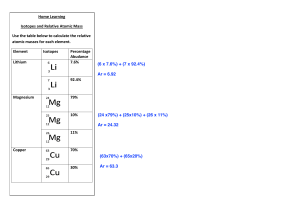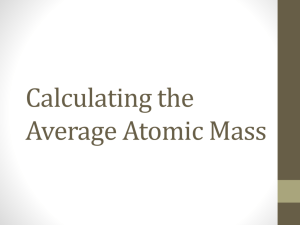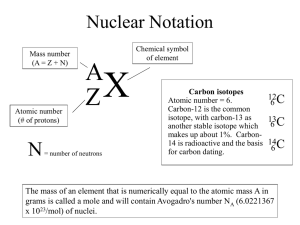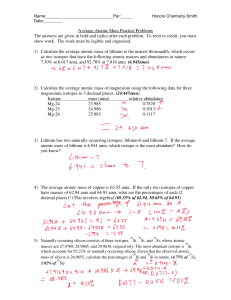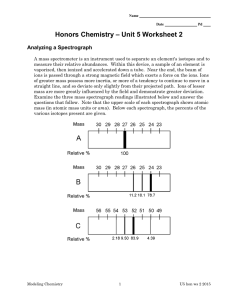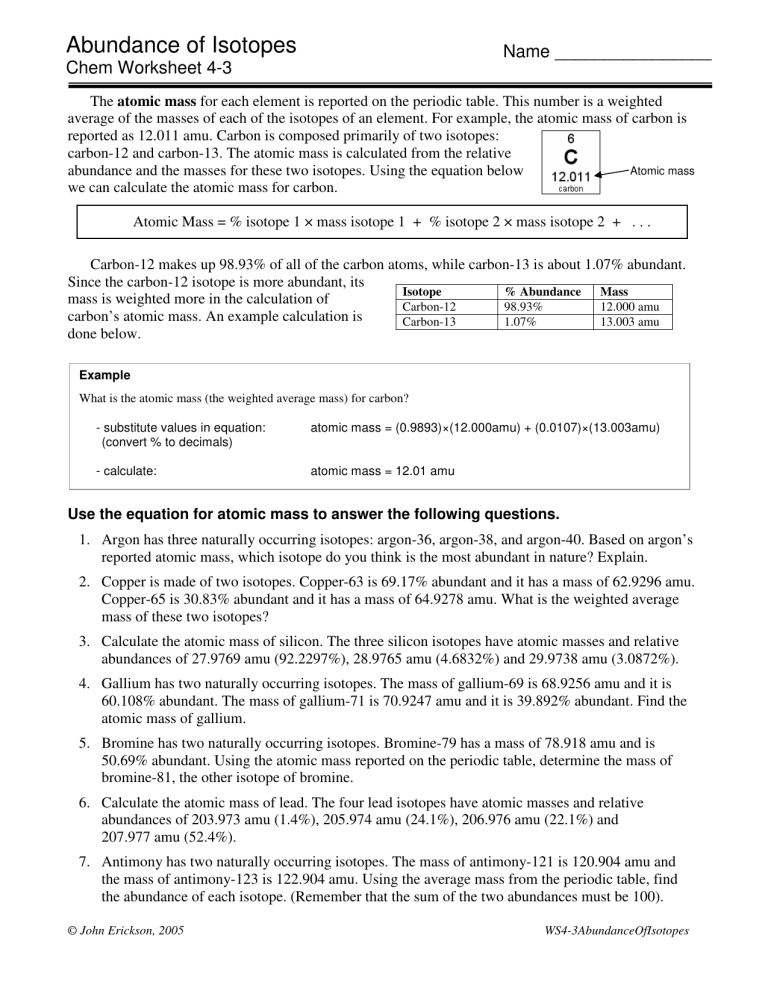
Abundance of Isotopes Name ________________ Chem Worksheet 4-3 The atomic mass for each element is reported on the periodic table. This number is a weighted average of the masses of each of the isotopes of an element. For example, the atomic mass of carbon is reported as 12.011 amu. Carbon is composed primarily of two isotopes: carbon-12 and carbon-13. The atomic mass is calculated from the relative Atomic mass abundance and the masses for these two isotopes. Using the equation below we can calculate the atomic mass for carbon. Atomic Mass = % isotope 1 × mass isotope 1 + % isotope 2 × mass isotope 2 + . . . Carbon-12 makes up 98.93% of all of the carbon atoms, while carbon-13 is about 1.07% abundant. Since the carbon-12 isotope is more abundant, its Isotope % Abundance Mass mass is weighted more in the calculation of Carbon-12 98.93% 12.000 amu carbon’s atomic mass. An example calculation is Carbon-13 1.07% 13.003 amu done below. Example What is the atomic mass (the weighted average mass) for carbon? - substitute values in equation: (convert % to decimals) atomic mass = (0.9893)×(12.000amu) + (0.0107)×(13.003amu) - calculate: atomic mass = 12.01 amu Use the equation for atomic mass to answer the following questions. 1. Argon has three naturally occurring isotopes: argon-36, argon-38, and argon-40. Based on argon’s reported atomic mass, which isotope do you think is the most abundant in nature? Explain. 2. Copper is made of two isotopes. Copper-63 is 69.17% abundant and it has a mass of 62.9296 amu. Copper-65 is 30.83% abundant and it has a mass of 64.9278 amu. What is the weighted average mass of these two isotopes? 3. Calculate the atomic mass of silicon. The three silicon isotopes have atomic masses and relative abundances of 27.9769 amu (92.2297%), 28.9765 amu (4.6832%) and 29.9738 amu (3.0872%). 4. Gallium has two naturally occurring isotopes. The mass of gallium-69 is 68.9256 amu and it is 60.108% abundant. The mass of gallium-71 is 70.9247 amu and it is 39.892% abundant. Find the atomic mass of gallium. 5. Bromine has two naturally occurring isotopes. Bromine-79 has a mass of 78.918 amu and is 50.69% abundant. Using the atomic mass reported on the periodic table, determine the mass of bromine-81, the other isotope of bromine. 6. Calculate the atomic mass of lead. The four lead isotopes have atomic masses and relative abundances of 203.973 amu (1.4%), 205.974 amu (24.1%), 206.976 amu (22.1%) and 207.977 amu (52.4%). 7. Antimony has two naturally occurring isotopes. The mass of antimony-121 is 120.904 amu and the mass of antimony-123 is 122.904 amu. Using the average mass from the periodic table, find the abundance of each isotope. (Remember that the sum of the two abundances must be 100). © John Erickson, 2005 WS4-3AbundanceOfIsotopes

